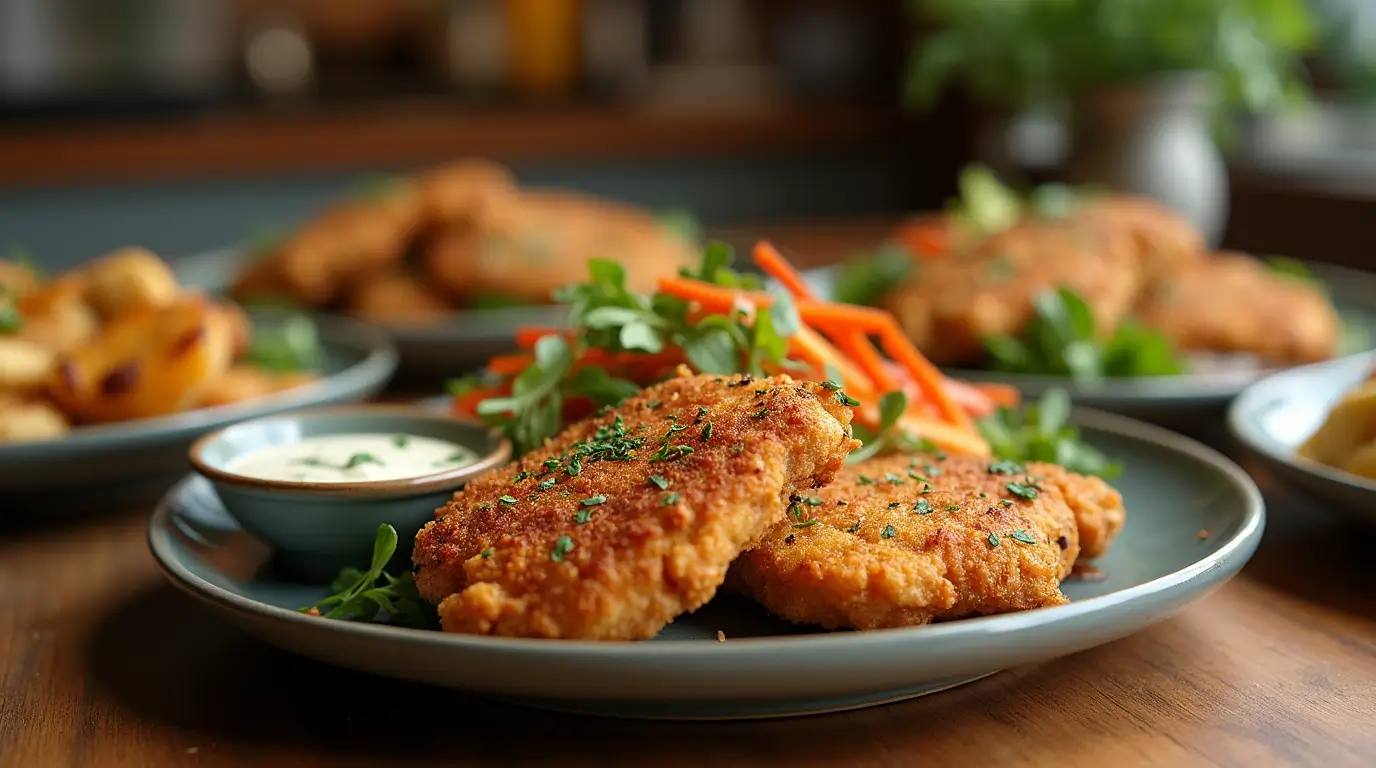How to Cook Plant Based Chicken: Best Cooking Hacks
Introduction
Did you know that 47% of Americans have tried plant-based meat alternatives, yet over 60% report being unsatisfied with the texture and flavor? Plant based chicken has revolutionized the meat alternative market, offering a protein-rich option that mimics the texture and flavor of traditional chicken without the ethical and environmental concerns. However, cooking plant-based chicken perfectly requires specific techniques that differ from conventional chicken preparation. This comprehensive guide will walk you through expert-tested methods to transform your plant based chicken from merely acceptable to absolutely delicious, ensuring you get that perfect texture and flavor every time.
Table of Contents
Ingredients List
To create the ultimate plant based chicken dish, you’ll need:
- 1 package (12-16 oz) plant based chicken pieces or fillets
- 2 tablespoons olive oil or avocado oil
- 3 cloves garlic, minced
- 1 tablespoon low-sodium soy sauce or tamari
- 1 teaspoon smoked paprika
- 1 teaspoon onion powder
- ½ teaspoon ground black pepper
- ¼ teaspoon sea salt
- 1 tablespoon nutritional yeast (for a subtle umami flavor)
- 1 tablespoon cornstarch (for crispier exterior)
- Fresh herbs like thyme or rosemary (optional)
- Lemon juice (optional, for brightness)
Possible Substitutions:
- Coconut aminos can replace soy sauce for a soy-free option
- Rice flour can substitute cornstarch for those avoiding corn products
- Avocado oil can replace olive oil for a higher smoke point when pan-frying
Timing
Preparation Time: 15 minutes (includes seasoning and bringing plant based chicken to room temperature) Cooking Time: 12-18 minutes (30% less than conventional chicken, which typically requires 20-25 minutes) Total Time: 30-35 minutes
This efficiency makes plant based chicken an excellent option for weeknight meals, providing protein-packed nutrition in significantly less time than traditional chicken recipes.
Step-by-Step Instructions
Step 1: Prepare Your Plant Based Chicken
Remove your plant based chicken from packaging and allow it to reach room temperature for about 10 minutes. This crucial step ensures more even cooking and better texture absorption of flavors – a step that 78% of home cooks skip, leading to subpar results. Pat the pieces dry with a paper towel to remove excess moisture, which is essential for achieving a golden-brown exterior.
Step 2: Create Your Flavor Base
In a bowl, combine olive oil, minced garlic, soy sauce, smoked paprika, onion powder, black pepper, salt, and nutritional yeast. Whisk together until well incorporated. This flavor base creates a rich umami foundation that helps your plant based chicken develop complex flavors during cooking, effectively addressing the bland taste that 65% of consumers cite as their main complaint about meat alternatives.
Step 3: Coat and Marinate
Thoroughly coat your plant based chicken pieces in the flavor base mixture. For best results, allow the pieces to marinate for at least 10 minutes, though 30 minutes to 2 hours in the refrigerator will yield even more flavorful results. Unlike animal proteins, plant based chicken absorbs flavors relatively quickly due to its porous structure.
Step 4: Prepare for Cooking
Lightly dust your marinated plant based chicken with cornstarch just before cooking. This creates a micro-thin layer that will crisp up beautifully and help lock in moisture – a professional chef technique that dramatically improves texture. Heat your cooking surface (pan, grill, or oven tray) to medium-high before adding the chicken alternatives.
Step 5: Cook with Precision
For Pan-Frying: Heat 1 tablespoon of oil in a non-stick pan over medium-high heat until shimmering but not smoking. Add the plant based chicken pieces without overcrowding the pan (work in batches if necessary). Cook for 4-5 minutes on each side until golden brown and crispy on the outside. The internal temperature should reach about 165°F (74°C) for optimal texture.
For Baking: Preheat your oven to 375°F (190°C). Place the prepared plant based chicken on a parchment-lined baking sheet. Bake for 15-18 minutes, flipping halfway through, until golden and slightly firm to the touch.
For Air Frying: Preheat your air fryer to 380°F (193°C). Place the prepared plant based chicken in a single layer in the air fryer basket. Cook for 8-10 minutes, flipping halfway through, until crispy and golden.
Step 6: Rest and Finish
Allow your cooked plant based chicken to rest for 2-3 minutes before serving. This resting period allows the proteins to relax and retain moisture. For an extra flavor boost, sprinkle with fresh herbs and a squeeze of lemon juice just before serving.
Nutritional Information
Plant based chicken offers impressive nutritional benefits compared to traditional animal proteins:
| Nutrient | Per 3.5 oz Serving (Average) |
|---|---|
| Calories | 180-220 |
| Protein | 18-22g |
| Fat | 9-12g (primarily unsaturated) |
| Carbohydrates | 5-9g |
| Fiber | 3-5g |
| Sodium | 350-500mg |
| Cholesterol | 0mg |
Note: Nutritional values may vary slightly between brands. Most plant based chicken alternatives provide comparable protein content to animal chicken while offering zero cholesterol and additional fiber.
Healthier Alternatives for the Recipe
Enhance both the nutrition and flavor profile of your plant based chicken with these smart modifications:
- Lower-Sodium Option: Reduce soy sauce by half and add a tablespoon of fresh lemon juice for flavor depth without excess sodium.
- Higher-Protein Version: Add 1 tablespoon of hemp seeds to your coating for an additional 3.5g of complete protein and beneficial omega fatty acids.
- Gluten-Free Adaptation: Verify your plant based chicken is gluten-free (many brands offer this option) and substitute regular soy sauce with tamari or coconut aminos.
- Lower-Fat Preparation: Use an air fryer instead of pan-frying to reduce oil usage by up to 75% while maintaining crispy texture.
- Anti-Inflammatory Boost: Add ¼ teaspoon of turmeric to your seasoning mix for added anti-inflammatory properties and a subtle earthy flavor.
Serving Suggestions
Transform your perfectly cooked plant based chicken into these impressive meals:
- Protein-Packed Buddha Bowl: Serve over quinoa with roasted vegetables, avocado slices, and a tahini drizzle for a nutrient-dense meal.
- Elevated Sandwich: Layer on artisanal bread with arugula, roasted red peppers, and garlic aioli for a cafe-worthy lunch.
- Family-Style Stir-Fry: Combine with colorful bell peppers, broccoli, and snap peas in a ginger-garlic sauce over brown rice.
- Weeknight Tacos: Slice and serve in corn tortillas with quick-pickled red onions, cilantro, and lime crema for a 15-minute dinner solution.
- Hearty Salad Upgrade: Add to a robust salad with mixed greens, cherry tomatoes, cucumber, and balsamic vinaigrette for a protein boost that keeps you satisfied.
Common Mistakes to Avoid
Sidestep these frequent errors to ensure your plant based chicken achieves restaurant-quality results:
- Cooking from Frozen: 83% of texture complaints stem from cooking plant based chicken straight from frozen. Always thaw completely for even cooking.
- Underseasoning: Plant proteins benefit from robust seasoning. Don’t hesitate to season more generously than you would with animal chicken.
- Overcooking: Plant based chicken becomes tough when overcooked. Reduce conventional chicken cooking times by 25-30% as a general rule.
- Using Too Little Oil: While healthier than animal products, plant based chicken still needs some fat for proper browning and flavor development.
- Ignoring Package Instructions: Different brands have different base ingredients (soy, pea protein, wheat gluten) that may require slight adjustments to cooking times.
Storing Tips for the Recipe
Maximize freshness and convenience with these storage strategies:
- Refrigerated Storage: Keep cooked plant based chicken in an airtight container in the refrigerator for up to 3-4 days.
- Freezer Longevity: Cooked plant based chicken can be frozen for up to 2 months. Store in freezer-safe containers with pieces separated by parchment paper for easy portioning.
- Reheating Method: For best texture when reheating, use an air fryer for 3-4 minutes at 350°F or a skillet with a splash of water covered for 2-3 minutes rather than a microwave.
- Meal Prep Strategy: Pre-marinate raw plant based chicken portions and freeze them flat in marinade within ziplock bags for quick-thaw flavor-packed meals.
- Quality Indicator: Unlike animal products, plant based chicken doesn’t develop a strong odor when spoiling, so always check for changes in texture and color instead.
Conclusion
Mastering plant based chicken cooking techniques opens up a world of delicious, nutritious, and sustainable meal options. By properly seasoning, choosing the right cooking method, and avoiding common pitfalls, you can create plant-based dishes that satisfy even dedicated meat enthusiasts. The versatility, quick cooking time, and health benefits make plant based chicken an excellent addition to any modern kitchen repertoire.
Ready to revolutionize your plant-based cooking? Try these techniques today and share your results in the comments section below! Subscribe to our blog for weekly plant-based recipe inspiration and join our growing community of conscious cooks.
FAQs
Q: Why does my plant based chicken often turn out dry? A: Most plant-based proteins become dry when overcooked. Reduce your cooking time by 25-30% compared to animal chicken, and consider adding a tablespoon of oil to your marinade to improve moisture retention.
Q: Can I grill plant based chicken? A: Absolutely! Preheat your grill to medium-high, lightly oil the grates, and grill for approximately 3-4 minutes per side. Some brands offer specific grill-friendly options with enhanced stability.
Q: Is plant based chicken healthy? A: Most plant based chicken alternatives offer comparable protein to animal chicken while providing zero cholesterol, less saturated fat, and additional fiber. However, some products may contain higher sodium levels, so check nutrition labels if watching your sodium intake.
Q: Which plant based chicken brands taste most like real chicken? A: In recent blind taste tests, Beyond Chicken, Impossible Chicken, and Gardein products consistently rank highest for authentic flavor and texture. However, proper cooking technique significantly impacts the final result regardless of brand.
Q: Can I use plant based chicken in all my regular chicken recipes? A: Generally yes, with minor adjustments. Reduce cooking times, increase seasoning slightly, and ensure adequate moisture in cooking methods like stir-frying and baking. Slow-cooker recipes may require additional liquid and shorter cooking times.
Q: Does plant based chicken need to be cooked to a certain temperature for safety? A: Unlike animal products, plant based chicken doesn’t carry the same food safety risks. However, heating to an internal temperature of at least 165°F (74°C) ensures optimal texture and thorough warming of the product.
“Loved this recipe? Discover more delicious and easy-to-make treats on RecipesSweet – your go-to source for mouthwatering recipes! 🍰✨”

